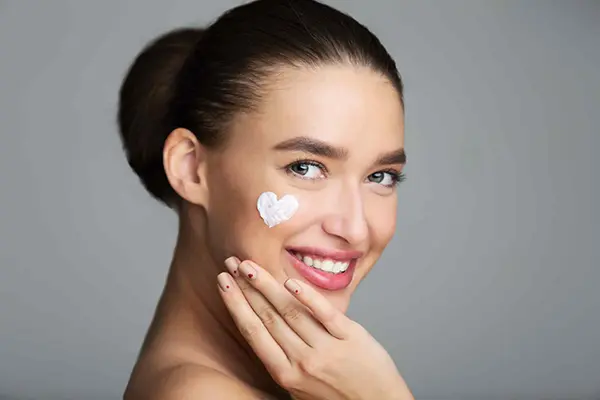As fall arrives, bringing cozy sweaters, pumpkin spice lattes, and crisp air, your skin may feel the change too. The days of battling sweat and shine are over. Now, it’s about tackling dryness, dullness, and the effects of indoor heating. Just as you swap your summer wardrobe for warmer layers, your skincare routine needs a seasonal upgrade. This helps your skin handle cooler temperatures and drier air.
Simple changes, like switching cleansers and adding hydration, can make a big difference. With these tweaks, you can keep your glow through the fall. Let’s explore the best ways to transition your skincare routine and keep your skin happy all season!
Table of contents
- 10 Easy Tips to Transition Your Skincare Routine from Summer to Fall
- 1. Switch to a Gentle Cleanser
- 2. Exfoliate, But Don’t Overdo It
- 3. Boost Hydration with a Heavier Moisturizer
- 4. Add a Hydrating Toner
- 5. Don’t Skip the Sunscreen
- 6. Pay Extra Attention to Lips and Eyes
- 7. Incorporate Antioxidants and Retinoids
- 8. Hydrate from the Inside Out
- 9. Treat Yourself to At-Home Facials
- 10. Upgrade Your Body Care Routine
10 Easy Tips to Transition Your Skincare Routine from Summer to Fall
1. Switch to a Gentle Cleanser
Foaming or oil-control cleansers work well in summer for managing sweat and oil. However, as fall arrives, they can strip your skin of its natural oils, leaving it dry and tight. To maintain balanced and healthy skin in cooler weather, switch to a gentle, hydrating cleanser. Look for ingredients like glycerin and ceramides. These help cleanse your skin while maintaining its moisture and natural barrier, preventing dryness and irritation.
Quick Tips for Choosing a Fall Cleanser:
- Go for Cream or Milk Cleansers: These are more moisturizing and gentle on your skin compared to gel cleansers.
- Pick pH-Balanced Formulas: A cleanser with a balanced pH (close to your skin’s natural pH of around 5.5) can help maintain your skin’s protective barrier, preventing it from becoming too dry or irritated in cooler weather.
- Avoid Harsh Ingredients: Skip cleansers with sulfates, strong fragrances, or alcohols, as they can dry out your skin even more.
- Try Oil Cleansers for Double Cleansing: If you’re dealing with a lot of makeup or sunscreen (which you should still be wearing daily!), an oil cleanser can be a game-changer. Start with an oil cleanser to break down makeup and sunscreen, then follow up with your gentle cleanser.

2. Exfoliate, But Don’t Overdo It
Exfoliating gives your skin a fresh start by removing dead cells that make it look dull. However, as the weather cools and air dries, over-exfoliating can harm your skin. This may lead to redness, irritation, and a weakened skin barrier. The goal is smooth, glowing skin—not irritation.
For fall, balance your skincare by using a mild exfoliant only once or twice a week. This keeps your skin bright without stripping its essential oils, which are crucial in low humidity. Opt for gentle options like lactic acid, which exfoliates and hydrates, or fruit enzymes that dissolve dead skin without harsh scrubbing.
Extra Tips for Fall Exfoliation:
- Choose Enzyme-Based Exfoliants: Instead of reaching for gritty scrubs, try enzyme exfoliants like papaya or pineapple enzymes. These work by gently dissolving the dead skin cells on the surface, which makes them perfect for sensitive or dry skin types that need a little extra TLC in fall. Enzyme masks are a great way to exfoliate without overdoing it.
- Incorporate AHA or BHA Once a Week: If you love the tingle of acids but find them too strong in the colder months, dial it back to once a week. Alpha Hydroxy Acids (AHAs) like glycolic or lactic acid are water-soluble and help with surface-level exfoliation, while Beta Hydroxy Acids (BHAs) like salicylic acid penetrate deeper to unclog pores. Both types can help keep your skin smooth and clear but in moderation!
- Try a Gentle Peeling Pad: For a quick and easy exfoliation, consider using gentle peeling pads soaked in mild acids like lactic or mandelic acid. They’re less intense than some serums and can be used to swipe away dead skin once a week. Just remember to follow up with a good moisturizer since acids can be drying.
- Avoid Physical Scrubs with Harsh Particles: Those scrubs with large, jagged particles like walnut shells can cause micro-tears in your skin, which isn’t ideal anytime but especially in the drier months. Stick to smoother, softer options like jojoba beads if you must have that scrubby feeling, but even then, less is more.
3. Boost Hydration with a Heavier Moisturizer
As the weather cools, humidity drops. The lightweight summer moisturizer you’ve been using might not keep your skin hydrated. Fall’s dry air requires more care. Switch to a richer moisturizer for deeper hydration.
Start by incorporating a hydrating toner or essence right after cleansing to prep your skin for moisture. Follow up with a heavier moisturizer or even layer a hydrating serum underneath for added benefits. The goal is to lock in moisture and strengthen your skin’s barrier, ensuring it stays soft, smooth, and supple all season long.
Key Ingredients for Fall Moisturizers:
- Hyaluronic Acid: This ingredient draws moisture into the skin, keeping it plump and hydrated.
- Ceramides: These lipids help rebuild and maintain your skin’s natural barrier, crucial for locking in moisture.
- Squalane: A lightweight, non-greasy oil that mimics your skin’s natural oils, providing excellent hydration and soothing properties.
Layer Up with a Hydrating Serum
If your skin is on the drier side, don’t just stop at moisturizer. Layer a hydrating serum underneath to give your skin an extra boost. Serums with ingredients like hyaluronic acid, glycerin, or niacinamide can penetrate deeper layers of the skin, offering intense hydration and helping to prep your skin for the heavier moisturizer that follows.
Consistency is key! Make sure you’re moisturizing twice a day—once in the morning to protect your skin throughout the day, and once at night to help repair and replenish while you sleep.

4. Add a Hydrating Toner
A hydrating toner can truly elevate your fall skincare routine, making it a must-have as the seasons change. As the air gets cooler and drier, your skin can start to lose moisture, leaving it feeling tight and dehydrated. That’s where a hydrating toner steps in. It not only helps balance your skin’s pH levels after cleansing but also adds an essential layer of hydration. This extra moisture primes your skin, making it more receptive to the serums and moisturizers you apply afterward, ensuring they work more effectively in your skincare routine.
When choosing a toner for fall, opt for alcohol-free options to protect your skin’s natural oils. Look for soothing and hydrating ingredients like rose water, which reduces inflammation, or chamomile, known for its calming effects. These ingredients soothe irritation, lock in moisture, and refresh your skin. This prepares your skin for the rest of your fall skincare routine.
5. Don’t Skip the Sunscreen
Even though the sun isn’t as intense in the fall, that doesn’t mean you can ditch your sunscreen as part of your skincare routine. UV rays, especially UVA rays, are sneaky and stick around all year long. They can easily penetrate through clouds and even your windows, causing damage to your skin and speeding up the aging process.
To keep your skin protected and healthy, make sure you’re using a broad-spectrum sunscreen with at least SPF 30 every single day. Yes, even when it’s cloudy or you’re mostly indoors. This simple habit will help you fend off sunspots, wrinkles, and other signs of premature aging. Your future self will thank you for it!
Consider Your Skin Type
If you have oily or acne-prone skin, you might worry that sunscreen will clog your pores or make your skin greasy. But there are so many options now, like lightweight gels or mattifying formulas that keep your skin protected without that heavy, greasy feel. For sensitive skin, look for mineral sunscreens with zinc oxide or titanium dioxide—they’re gentler on the skin and less likely to cause irritation. Incorporating the right sunscreen into your daily skincare routine ensures that your skin stays protected year-round, making it a crucial step no matter the season.

6. Pay Extra Attention to Lips and Eyes
The skin around your lips and eyes is some of the most delicate on your body, and it tends to take a hit when the cooler, drier air of fall rolls in. These areas can become especially prone to dryness, irritation, and even cracking if not properly cared for. To keep your lips soft and smooth, it’s time to incorporate a nourishing lip balm into your skincare routine, loaded with ingredients like beeswax, shea butter, and natural oils. These ingredients act as a barrier, locking in moisture and protecting your lips from the harsh, dry air.
Similarly, your eyes deserve some extra attention as the season changes. The skin around your eyes is thinner and more sensitive, making it more susceptible to dryness and fine lines. As part of your fall skincare routine, using a hydrating eye cream with powerhouse ingredients like hyaluronic acid or peptides can work wonders. Hyaluronic acid helps to attract and retain moisture, plumping up the skin and reducing the appearance of fine lines, while peptides support the skin’s structure, helping to firm and smooth the area.
Consider using a thicker, more intensive lip balm or eye cream as an overnight treatment. Products designed for nighttime use often have richer formulas, allowing them to work their magic while you sleep.
7. Incorporate Antioxidants and Retinoids
Fall is the perfect time to add antioxidants like vitamin C and retinoids to your skincare routine. Vitamin C brightens your skin, fades sunspots, and fights free radicals that cause aging and dullness. Using it in the morning can keep your complexion glowing as the days get shorter.
Retinoids, on the other hand, are great for cell turnover, helping your skin shed old cells and reveal fresh, new ones underneath. This process reduces fine lines, evens skin tone, and preps your skin for winter’s harsher conditions. Fall’s reduced sunlight makes it an ideal time to start using retinoids, but remember to ease in slowly—start with once or twice a week and always follow with a good moisturizer and sunscreen to protect your skin.
8. Hydrate from the Inside Out
Hydration is not just about what you put on your skin—it’s also about what you put into your body. Think of your skin as a reflection of how well-hydrated you are overall.
- Drink Plenty of Water: Water is essential for skin health. It helps flush out toxins and keeps your skin cells hydrated and plump. Aim for at least 8 glasses a day, and if plain water feels boring, try adding some fresh fruit like cucumber or lemon for a tasty twist.
- Eat Water-Rich Foods: Incorporate hydrating foods like cucumbers, watermelon, oranges, and strawberries into your diet. These fruits and veggies are not only delicious but also packed with water and nutrients that support skin hydration.
- Use a Humidifier: Indoor heating can dry out the air, leaving your skin parched. A humidifier adds moisture back into the air, helping to keep your skin hydrated. It’s especially beneficial to use one while you sleep.
- Sip on Herbal Teas: Herbal teas like chamomile and green tea are hydrating and packed with antioxidants that benefit your skin. Plus, they’re caffeine-free, so you can enjoy them without worrying about dehydration.
- Balance Caffeine and Alcohol: Caffeine and alcohol can dehydrate your skin, so try to limit your intake. If you can’t skip your morning coffee, make sure to drink extra water to balance it out.

9. Treat Yourself to At-Home Facials
Fall is the perfect time to treat yourself to some at-home facials—your skin will definitely thank you for it! As part of your fall skincare routine, these DIY pampering sessions can help address the dryness and dullness that often come with cooler weather. As the air gets drier and your skin might start feeling a bit neglected, incorporating regular at-home facials into your routine can rejuvenate your complexion and keep it looking fresh and radiant all season long.
Step1: Start by steaming your face to open up your pores—this is like hitting the reset button for your skin. You don’t need any fancy equipment; just lean over a bowl of hot water with a towel over your head to trap the steam.
Step 2: Once your pores are open, it’s time for some gentle exfoliation. Use a mild exfoliator with natural ingredients like oatmeal or fruit enzymes. This step is key for sloughing off dead skin cells, which can make your skin look dull, and it also preps your skin to better absorb the goodies you’re about to apply next.
Step3: Now, the best part: the nourishing mask. Fall is all about hydration, so go for a mask that’s packed with moisturizing ingredients like hyaluronic acid, honey, or avocado. Apply the mask generously and let it sit for 15-20 minutes while you relax with a good book or some soothing music.
Step4: When you rinse off the mask, your skin will feel refreshed and super soft. Plus, after a good facial, your skin is primed to soak up all the benefits of your moisturizing products, so don’t skip your serums and creams afterward. The result? A glowing, hydrated complexion that’s ready to take on the cooler months.
And hey, why not make this a weekly ritual? Your skin—and your soul—will love the extra attention.
10. Upgrade Your Body Care Routine
As you transition your facial skincare routine, don’t forget about your body. The cooler, drier air can sap moisture from all parts of your skin, not just your face. This seasonal change is a great opportunity to extend your skincare routine to your body, ensuring every inch of your skin stays hydrated and protected. Start by swapping out those lightweight lotions you loved in summer for richer body creams or oils that offer deep, lasting hydration.
Look for body care products packed with nourishing ingredients like shea butter, cocoa butter, and coconut oil. These natural moisturizers are excellent for keeping your skin soft, smooth, and supple, even when the air is crisp and dry. Shea butter, for example, is known for its intense moisturizing properties, making it perfect for combating the dryness that often comes with fall. Cocoa butter adds a protective layer that locks in moisture, while coconut oil penetrates deeply to provide hydration and help repair the skin barrier.
A pro tip: Apply your body lotion or cream right after you shower. When your skin is still slightly damp, it’s more receptive to absorbing moisture, so you’ll lock in all that hydration and keep your skin feeling comfortable and nourished all day long.
Conclusion for How to Transition Your Skincare Routine from Summer to Fall?
Wrapping up your summer skincare and transitioning into fall skincare routine doesn’t have to be a hassle—it’s all about making a few smart swaps and paying attention to what your skin needs as the weather changes. Richer moisturizers, gentle exfoliation, and consistent sunscreen use will keep your skin protected and glowing even when the temperatures drop. And remember, your skin is unique, so listen to it! If it feels dry, add more hydration; if it’s oily, adjust accordingly.
With these small adjustments, you’ll be ready to face fall with healthy, radiant skin that looks and feels amazing. So go ahead, enjoy the cozy vibes of fall, and let your skincare routine be just as comforting!
Related Posts:
Essential Skincare Routine for Oily Skin: Products and Practices
Nighttime Skincare Routine for Dry Skin: Expert Tips and Best Products
Top Tips for the Best Skincare Routine for Dry Skin
Skincare for Teenagers: Tips, Products, and Routines for Healthy Skin



